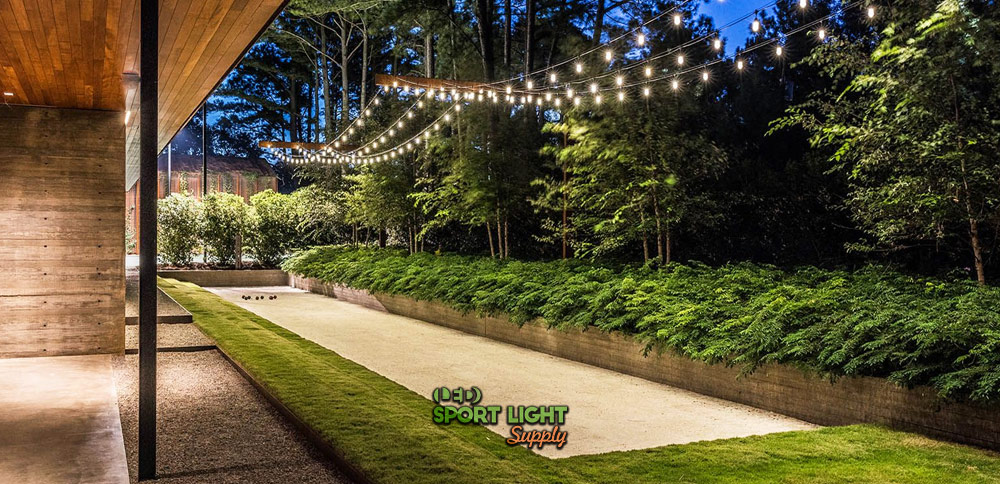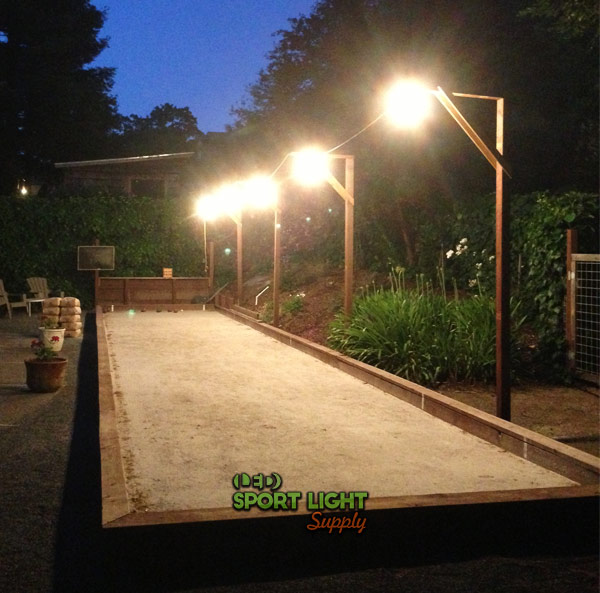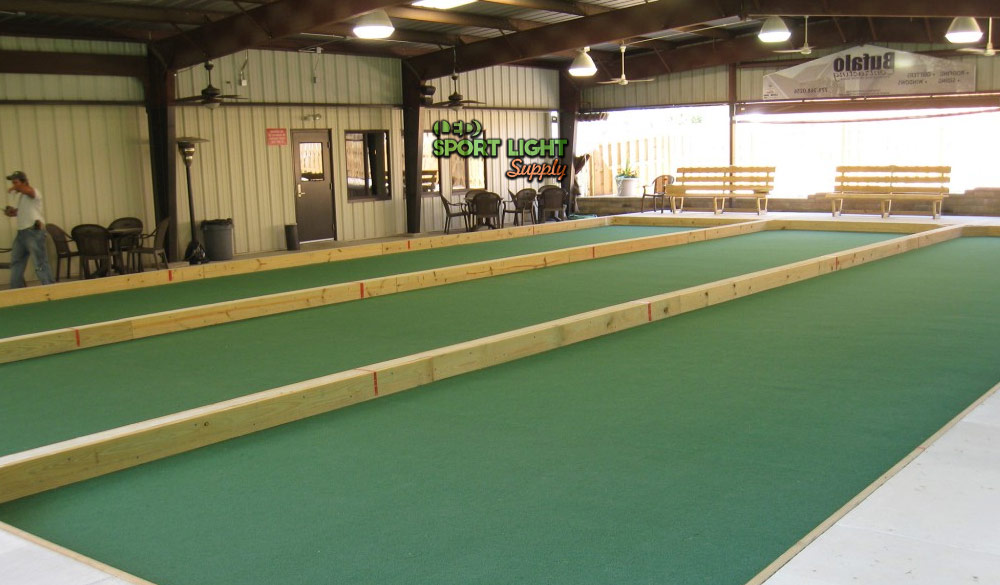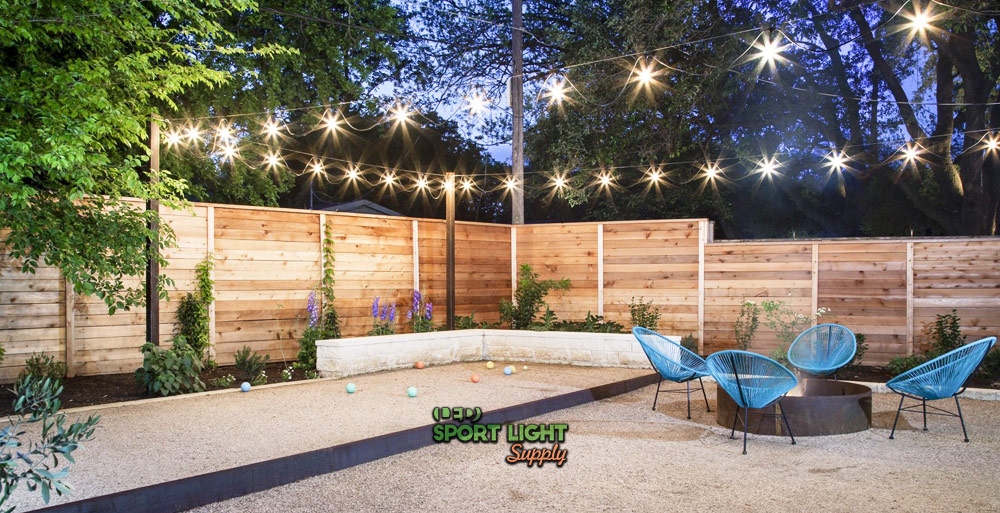The bocce ball court is a straightforward design, typically consisting of a long, flat strip of land bordered by gravel, clay, or crushed oyster shells. The court’s length may vary depending on its location, but it must be perfectly level. Unlike high-intensity sports venues, bocce ball courts do not require FIFA-standard lighting. Instead, they only need simple overhead lights to provide adequate illumination.
In this comprehensive guide, we will explore the lighting standards specifically for bocce ball courts. We will cover both outdoor and indoor lighting considerations, including detailed breakdowns of wattage and cost figures. This information will illustrate the significant reduction in energy consumption offered by LED lighting. Let’s get started!
Table of Contents
ToggleHow to Get Started with the Bocce Court Lighting Layout
Knowing the Field Size

The size of a bocce ball court can vary depending on the level of competition and the space available. For most purposes, the average bocce court measures approximately 26.5 meters (80 feet) in length and 4 meters (12 feet) in width. However, competition courts may extend up to 90 feet in length, though this is less common.
For backyard courts, the dimensions often range from 60 feet in length to 12 feet in width. The court’s size will influence the wattage needed and the total number of lumens required. Larger courts generally require more lighting to ensure proper illumination, so longer courts may necessitate additional lights.

Number of Light Poles for Outdoor Courts
Outdoor bocce courts measuring between 60 and 80 feet in length typically require 3 to 5 light poles along the edges. These poles should be evenly spaced along the two foul lines. An additional fixture can be positioned at one end of the court for player convenience. While there is no fixed rule for the number of lights required, at least two fixtures are recommended for the main court area. Longer courts should ideally have three lights spaced evenly along the edge.
This arrangement ensures that the lighting covers the court more effectively, with each light overlapping the adjacent sections. Light poles are commonly constructed from wood with an overhanging support beam, though metal poles are also used in newer installations.
Light Pole Height in Bocce Courts
For outdoor bocce courts, the light poles should generally be between 4 and 6 meters high. This height ensures that the balls in play are well-clear of any potential obstructions from higher tosses. Additionally, this height allows the floodlights to distribute their beam effectively over the 12-foot wide court.
When placing lights along the court’s edge, they can be slightly overhanging to provide more central illumination. Lights that do not overhang should be angled to ensure even coverage of the court surface. Overall, setting up the lighting system is relatively straightforward.
Ceiling Height for Indoor Courts

Indoor bocce courts are easier to light if you have sufficient space. A minimum ceiling height of 3 to 5 meters (9 to 15 feet) is recommended. This allows for the installation of ceiling-mounted or hanging lights directly above the court, providing better control over the lighting and allowing the use of smaller floodlights for uniform illumination.
Typically, two to three fixtures are sufficient for indoor courts, though additional lights can be added to illuminate surrounding areas, such as refreshment zones or spectator areas.
Distance Between Ceiling Lights for Indoor Courts
The distance between ceiling lights in an indoor bocce court generally ranges from 20 to 30 feet, depending on the size and wattage of the fixtures used. For example, fixtures with a light output equivalent to 100 watts each are common.
The placement of these fixtures should ensure that their beam angles effectively cover the length of the court. The height of the ceiling also affects the beam angle: higher ceilings require narrower beam angles, while lower ceilings benefit from wider beam spreads.

Bocce Court Lighting Ideas and Design
Lux Level Required for Bocce Ball Court Lights
Lux is a measure of illuminance, defining the brightness level of a light source. One footcandle is equivalent to 10.76 Lux. For recreational bocce courts, the recommended illumination level ranges between 150 and 250 Lux. In contrast, for higher competition events, lighting levels can range from 500 to 750 Lux.
To convert Lux to Lumens, multiply the Lux value by 10.76. For example, 150 Lux equates to approximately 1,614 Lumens, while 750 Lux equals about 8,070 Lumens. Although Lux and Lumens are closely related, understanding these conversions helps in estimating the required lighting levels for various court settings.
Lighting Uniformity
Lighting uniformity measures how evenly light is distributed across the court surface. This is assessed at a height of 1 meter above the ground within a square meter area. For recreational courts, uniformity ratings typically range from 0.4 to 0.5. For competitive courts, this can range from 0.6 to 0.7.
Achieving good lighting uniformity ensures that light levels are consistent across the playing surface, which is crucial for both recreational and competitive play. Uniform lighting minimizes shadows and provides a balanced playing environment.
Color Rendering Index (CRI)
The Color Rendering Index (CRI) gauges how accurately a light source displays colors compared to natural light. For bocce ball courts, a CRI rating of at least 70 is generally sufficient. This allows players to see the colorful balls clearly. In more competitive settings, a CRI of 80 may be preferred, but higher ratings are usually unnecessary.
CRI is important for visibility and accurate color representation, particularly in competitive scenarios where precision matters.
Color Temperature
Color temperature impacts the ambiance and visibility on the court. For bocce ball, a color temperature of around 4000K is ideal. This provides a warm, comfortable light with an orange hue, similar to typical indoor lighting. This temperature is pleasant and sufficient for casual play.
For competitive play, a color temperature up to 4500K can be used. However, temperatures above this may result in harsh lighting, which can be distracting and uncomfortable.
Flicker-Free Lighting
Flicker-free lighting is essential for both indoor and outdoor bocce courts. Traditional halogen or filament lights can produce noticeable flicker, which can be distracting. LED lights, however, offer a stable light source with no visible flicker. The rapid bursts of light from LEDs are imperceptible to the human eye, providing consistent illumination without the interference of flicker.
How Many Watts Are Needed for a Bocce Ball Court?
To determine the appropriate lighting requirements for a bocce ball court aiming for an illumination level of 200 Lux, you need to follow a detailed calculation process. Begin by multiplying 200 Lux by the court’s dimensions of 26.5 meters in length and 4 meters in width, and then factor in a light loss adjustment of 1.2. This adjustment accounts for potential losses in light intensity due to factors such as light absorption and dispersion. The calculation is as follows:
200 Lux × 26.5 meters × 4 meters × 1.2 = 25,440 lumens
This total of 25,440 lumens represents the amount of light required to achieve the desired Lux level on the court. To estimate the wattage needed for LED lighting, divide the total lumens by the lumens produced per watt. Assuming that LED lights provide approximately 150 lumens per watt, the calculation is:
25,440 / 150 = 169.6 watts
This indicates that you would need around 170 watts of LED lighting to meet the requirement. For practical installation, this translates to using two LED light fixtures, each rated at 100 watts, mounted on each pole.
In contrast, if you opt for halogen lights, which are less efficient compared to LEDs, you would need about ten times the wattage to achieve the same level of illumination. This significant increase in wattage highlights the efficiency advantages of LED lighting.
To further assess the energy consumption, consider that if you use 200 watts of lighting for the bocce court for an average of 8 hours a day, the daily energy consumption can be calculated as follows:
200 watts × 8 hours / 1000 = 1.6 kWh
To determine the associated electricity cost, multiply the daily energy consumption by the cost per kilowatt-hour (kWh). Assuming an electricity rate of 10 cents per kWh, the cost calculations are:
| Cost Type | Calculation | Amount |
|---|---|---|
| Daily Cost | 1.6 kWh × $0.10 | $0.16 |
| Monthly Cost | $0.16 × 30 days | $4.80 |
| Annual Cost | $0.16 × 365 days | $57.60 |
Thus, the estimated annual electricity cost for using LED lighting for a bocce ball court is approximately 57.60 dollars.
What Lights Are Used in Bocce Courts?
Flood Lights
Floodlights are essential fixtures for illuminating large areas, such as a bocce ball court. These lights are designed to cover extensive surface areas evenly. The effectiveness of floodlights depends on their mounting height. When mounted high, floodlights typically have narrower beam angles, allowing the light to spread out over a larger area. Conversely, when placed closer to the ground, a wider beam angle is preferred to ensure even light distribution.
For indoor bocce ball courts with high ceilings, it’s important to specify the ceiling height when ordering floodlights. This ensures that the light is directed where needed and minimizes spill light that could cause distractions.
Landscape Lights
Landscape lighting enhances the aesthetic appeal of outdoor spaces, such as gardens and backyard areas. While primarily decorative, landscape lights can also be used around a bocce ball court to create a pleasant ambiance. These are usually smaller fixtures, such as pot lights, that are embedded in the court’s wooden border. Although they provide minimal illumination for gameplay, they add to the visual appeal and help in creating a relaxing environment for night-time games.
Additionally, landscape lights often include trail lights on posts, which guide players and spectators around the court area, enhancing safety and visibility.
Solar Bocce Ball Court LED Lights
Solar-powered LED lights are an excellent choice for outdoor bocce ball courts. These lights operate independently of the electrical grid, drawing power from the sun through integrated solar panels. They store energy in lithium-ion batteries and can provide illumination for 4 to 8 hours, depending on the battery’s capacity.
Solar lights are low-maintenance and cost-effective, as they do not incur ongoing electricity costs. However, they do require periodic cleaning of the solar panels to ensure optimal performance. A simple wipe with a soft sponge or baby wipe is usually sufficient to remove dust and debris.
Our Conclusion
This guide provides an overview of various lighting options for bocce ball courts, focusing on the benefits of each type. Whether you’re constructing a new court or upgrading an existing one, consider the advantages of LED lighting. With its cost-effective lifespan and continuous technological improvements, LED lighting offers a compelling choice for both indoor and outdoor bocce ball court illumination. If you have any questions or need further assistance, feel free to contact us for more information.
